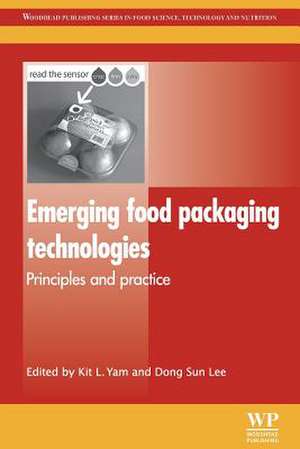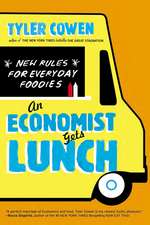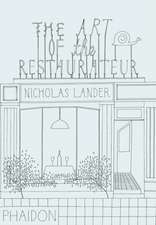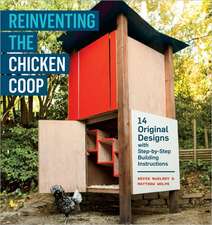Emerging Food Packaging Technologies: Principles and Practice: Woodhead Publishing Series in Food Science, Technology and Nutrition
Editat de Kit L Yam, Dong Sun Leeen Limba Engleză Paperback – 18 aug 2016
- Reviews advances in packaging materials, the design and implementation of smart packaging techniques, and developments in response to growing concerns about packaging sustainability
- Considers intelligent packaging and how advances in the consumer/packaging interface can improve food safety and quality
- Examines developments in packaging materials, nanocomposites, emerging coating technologies, light-protective and non-thermal process packaging and the safety of plastics as food packaging materials
Din seria Woodhead Publishing Series in Food Science, Technology and Nutrition
- 15%
 Preț: 391.19 lei
Preț: 391.19 lei - 24%
 Preț: 1210.03 lei
Preț: 1210.03 lei - 24%
 Preț: 946.43 lei
Preț: 946.43 lei - 24%
 Preț: 960.56 lei
Preț: 960.56 lei - 23%
 Preț: 1419.50 lei
Preț: 1419.50 lei - 9%
 Preț: 1205.99 lei
Preț: 1205.99 lei - 24%
 Preț: 1189.10 lei
Preț: 1189.10 lei - 9%
 Preț: 1006.66 lei
Preț: 1006.66 lei - 9%
 Preț: 984.09 lei
Preț: 984.09 lei - 9%
 Preț: 1206.85 lei
Preț: 1206.85 lei - 24%
 Preț: 1081.43 lei
Preț: 1081.43 lei - 24%
 Preț: 1185.22 lei
Preț: 1185.22 lei - 9%
 Preț: 922.07 lei
Preț: 922.07 lei - 24%
 Preț: 1192.22 lei
Preț: 1192.22 lei - 9%
 Preț: 1215.75 lei
Preț: 1215.75 lei - 24%
 Preț: 1162.37 lei
Preț: 1162.37 lei - 9%
 Preț: 950.09 lei
Preț: 950.09 lei - 24%
 Preț: 1162.62 lei
Preț: 1162.62 lei - 24%
 Preț: 801.31 lei
Preț: 801.31 lei - 27%
 Preț: 379.84 lei
Preț: 379.84 lei - 29%
 Preț: 1336.07 lei
Preț: 1336.07 lei - 24%
 Preț: 798.74 lei
Preț: 798.74 lei - 24%
 Preț: 1333.02 lei
Preț: 1333.02 lei - 9%
 Preț: 1018.93 lei
Preț: 1018.93 lei - 31%
 Preț: 922.77 lei
Preț: 922.77 lei - 9%
 Preț: 1045.58 lei
Preț: 1045.58 lei - 24%
 Preț: 1131.77 lei
Preț: 1131.77 lei - 23%
 Preț: 1635.83 lei
Preț: 1635.83 lei - 9%
 Preț: 1277.62 lei
Preț: 1277.62 lei - 24%
 Preț: 1049.04 lei
Preț: 1049.04 lei - 24%
 Preț: 1134.60 lei
Preț: 1134.60 lei - 9%
 Preț: 1076.36 lei
Preț: 1076.36 lei - 24%
 Preț: 1158.21 lei
Preț: 1158.21 lei - 9%
 Preț: 1065.06 lei
Preț: 1065.06 lei - 9%
 Preț: 1067.39 lei
Preț: 1067.39 lei - 24%
 Preț: 812.03 lei
Preț: 812.03 lei - 9%
 Preț: 1203.13 lei
Preț: 1203.13 lei - 23%
 Preț: 1237.19 lei
Preț: 1237.19 lei - 24%
 Preț: 948.79 lei
Preț: 948.79 lei - 23%
 Preț: 1138.06 lei
Preț: 1138.06 lei - 9%
 Preț: 868.43 lei
Preț: 868.43 lei - 24%
 Preț: 871.98 lei
Preț: 871.98 lei - 20%
 Preț: 1272.59 lei
Preț: 1272.59 lei - 29%
 Preț: 1195.06 lei
Preț: 1195.06 lei - 9%
 Preț: 1002.45 lei
Preț: 1002.45 lei - 9%
 Preț: 505.72 lei
Preț: 505.72 lei - 9%
 Preț: 1062.13 lei
Preț: 1062.13 lei - 24%
 Preț: 1306.94 lei
Preț: 1306.94 lei
Preț: 1131.67 lei
Preț vechi: 1243.59 lei
-9% Nou
Puncte Express: 1698
Preț estimativ în valută:
216.57€ • 224.82$ • 180.58£
216.57€ • 224.82$ • 180.58£
Carte tipărită la comandă
Livrare economică 15-29 martie
Preluare comenzi: 021 569.72.76
Specificații
ISBN-13: 9780081016398
ISBN-10: 0081016395
Pagini: 512
Dimensiuni: 156 x 234 x 26 mm
Greutate: 0.71 kg
Editura: ELSEVIER SCIENCE
Seria Woodhead Publishing Series in Food Science, Technology and Nutrition
ISBN-10: 0081016395
Pagini: 512
Dimensiuni: 156 x 234 x 26 mm
Greutate: 0.71 kg
Editura: ELSEVIER SCIENCE
Seria Woodhead Publishing Series in Food Science, Technology and Nutrition
Cuprins
Contributor contact details
Woodhead Publishing Series in Food Science, Technology and Nutrition
Preface
Chapter 1: Emerging food packaging technologies: an overview
Abstract:
1.1 Introduction
1.2 Driving forces for innovations in food packaging
1.3 Emerging technologies to improve the sustainability of the food supply system
1.4 Tables for evaluating emerging food packaging technologies
Part I: Developments in active packaging
Chapter 2: Controlled release food and beverage packaging
Abstract:
2.1 Introduction
2.2 Useful terms for controlled release packaging (CRP)
2.3 Scientific evidence to support controlled release packaging (CRP)
2.4 Conceptual framework
2.5 Process variables
2.6 Structure variables
2.7 Property variables
2.8 Food variables
2.9 Target release rate
2.10 Potential food applications
Chapter 3: Active antimicrobial food and beverage packaging
Abstract:
3.1 Introduction
3.2 Antimicrobial agents
3.3 Active packaging manufacture and application
3.4 Measurement of antimicrobial activity
3.5 Future trends
3.6 Sources of further information and advice
3.7 Acknowledgements
Chapter 4: Active nanocomposites for food and beverage packaging
Abstract:
4.1 Introduction
4.2 Free radical scavenging nanocomposites
4.3 Oxygen scavenging nanocomposites
4.4 Antimicrobial nanocomposites
4.5 Future trends
Chapter 5: Edible chitosan coatings for fresh and minimally processed foods
Abstract:
5.1 Introduction
5.2 Antimicrobial activity of chitosan
5.3 Antioxidant properties of chitosan
5.4 Emulsification properties of chitosan
5.5 Characterization of chitosan-based film-forming dispersions
5.6 Physicochemical characteristics of chitosan-based coatings
5.7 Antimicrobial activity of chitosan-based coatings
5.8 Application of chitosan coatings to fresh and minimally processed foods
5.9 Future trends
5.10 Acknowledgements
Chapter 6: Flavor-release food and beverage packaging
Abstract:
6.1 Introduction
6.2 Mechanism of flavor release from package to food
6.3 Impact of diffusion in the packaging material on flavor release kinetics
6.4 Practical applications and commercial examples
6.5 Safety issues
Chapter 7: Emerging packaging technologies for fresh produce
Abstract:
7.1 Introduction
7.2 Modified atmosphere packaging (MAP)
7.3 Active packaging
7.4 Antimicrobial packaging
7.5 Edible coatings
7.6 Combining different technologies
7.7 Conclusion and future trends
Part II: Intelligent packaging and the consumer/packaging interface
Chapter 8: Intelligent packaging to enhance food safety and quality
Abstract:
8.1 Introduction
8.2 Basic concepts of intelligent packaging (IP)
8.3 Smart package devices
8.4 Applications of intelligent packaging (IP) to enhance food safety and biosecurity
8.5 A conceptual framework for an intelligent decision support system
8.6 Conclusions
Chapter 9: Radio-frequency identifiction (RFID) for food and beverage packaging applications
Abstract:
9.1 Introduction
9.2 Principles of radio-frequency identification (RFID)
9.3 Applications of radio-frequency identification (RFID) in food and beverage packaging
9.4 Future trends
9.5 Conclusions
9.6 Sources of further information and advice
Chapter 10: Advances in freshness and safety indicators in food and beverage packaging
Abstract:
10.1 Introduction
10.2 Principles of freshness and safety indicators in food and beverage packaging
10.3 Current technologies and their limitations
10.4 Recent advances in freshness and safety indicators and their potential applications in food and beverage packaging
10.5 Future trends
10.6 Sources of further information and advice
10.7 Acknowledgement
Chapter 11: Improving the consumer/packaging interface: smart packaging for enhanced convenience, functionality and communication
Abstract:
11.1 Introduction
11.2 Improved convenience, openability and functionality
11.3 Providing clearer, more effective communication
11.4 Drivers and barriers to adoption
11.5 Conclusions
Chapter 12: Tamper-evident food and beverage packaging
Abstract:
12.1 Introduction
12.2 What is tamper evidence?
12.3 Acts of tampering
12.4 Application of tamper evidence to food and beverage packs
12.5 Future trends
12.6 Conclusion
Part III: Developments in packaging materials
Chapter 13: Nanocomposites for food and beverage packaging
Abstract:
13.1 Introduction
13.2 Nanofillers and nanocomposites
13.3 Current commercial application of nanocomposites in food and beverage packaging
13.4 State-of-the-art nanocomposites
13.5 Conclusions
Chapter 14: Emerging coating technologies for food and beverage packaging materials
Abstract:
14.1 Introduction
14.2 Coatings for food and beverage packaging applications: from the past to the present
14.3 Driving forces for developments in coating technologies and materials
14.4 New coating materials
14.5 Physico-chemical approaches for the development of coating materials
14.6 Nanotechnology and the development of coatings for food and beverage packaging materials
14.7 Active coatings for food and beverage packaging materials
14.8 Applications of the latest developments in coating technologies to improve product quality
14.9 Future trends
Chapter 15: Light-protective packaging materials for foods and beverages
Abstract:
15.1 Introduction
15.2 Effect of ultraviolet and visible light wavelengths on sensory and nutritional quality of foods and beverages
15.3 Improving the light barrier properties of food and beverage packaging materials
15.4 Selecting light barrier properties of packaging to improve sensory and nutritive quality of foods and beverages
15.5 Future trends
15.6 Sources of further information and advice
Chapter 16: Packaging materials for non-thermal processing of food and beverages
Abstract:
16.1 Introduction
16.2 Non-thermal processing of foods and beverages
16.3 Selection of packaging materials for non-thermal processing
16.4 Future trends
Chapter 17: Safety and regulatory aspects of plastics as food packaging materials
Abstract:
17.1 Introduction
17.2 Indirect food additives
17.3 Nanotechnology in food contact materials
17.4 Migration of additives
17.5 Indian Standards for overall migration
17.6 US Food and Drug Administration (US FDA) Code of Federal Regulations (CFR)
17.7 European Commission Directives on plastic containers for foods
17.8 Specific migration curve of toxic additives
17.9 Recent problems in specific migration
17.10 Future trends
17.12 Appendix Abbreviations
Part IV: Environmentally compatible food packaging
Chapter 18: Eco-design of food and beverage packaging
Abstract:
18.1 Introduction: adding sustainability to packaging functions
18.2 Principles of eco-design
18.3 Eco-design of food and beverage packaging
18.4 Case study: 100% compostable packaging of SunChips® and electronic delivery truck of Frito Lay
18.5 Conclusion
Chapter 19: Life cycle assessment (LCA) of food and beverage packaging
Abstract:
19.1 Introduction
19.2 Life cycle assessment (LCA) and sustainability
19.3 Life cycle assessment (LCA) in the food and beverage packaging industry
19.4 Using life cycle thinking to improve the sustainability of food and beverage packaging
19.5 Future trends
Chapter 20: Smarter packaging for consumer food waste reduction
Abstract:
20.1 Food waste: scale of problem
20.2 Sustainability and ecological footprinting
20.3 Sustainability of food waste versus packaging waste
20.4 Food packaging and food waste
20.5 Food-saving packaging
20.6 Summary and conclusions
20.7 Acknowledgment
Chapter 21: Utilization of biobased polymers in food packaging: assessment of materials, production and commercialization
Abstract:
21.1 Introduction: rationale and need for biobased food packaging
21.2 The environmental impact of conventional food packaging
21.3 Opportunities for renewable polymers
21.4 Production of biobased food packaging materials
21.5 Hybrid blends and composites
21.6 New developments in the production of packaging from recycled lignocellulosic fiber and renewable materials
21.7 Assessing the biodegradability of renewable materials in food packaging
21.8 Biodegradable packaging life cycle assessment
21.9 Food safety concerns, applications and adoption by the industry
21.10 Future trends
Index
Woodhead Publishing Series in Food Science, Technology and Nutrition
Preface
Chapter 1: Emerging food packaging technologies: an overview
Abstract:
1.1 Introduction
1.2 Driving forces for innovations in food packaging
1.3 Emerging technologies to improve the sustainability of the food supply system
1.4 Tables for evaluating emerging food packaging technologies
Part I: Developments in active packaging
Chapter 2: Controlled release food and beverage packaging
Abstract:
2.1 Introduction
2.2 Useful terms for controlled release packaging (CRP)
2.3 Scientific evidence to support controlled release packaging (CRP)
2.4 Conceptual framework
2.5 Process variables
2.6 Structure variables
2.7 Property variables
2.8 Food variables
2.9 Target release rate
2.10 Potential food applications
Chapter 3: Active antimicrobial food and beverage packaging
Abstract:
3.1 Introduction
3.2 Antimicrobial agents
3.3 Active packaging manufacture and application
3.4 Measurement of antimicrobial activity
3.5 Future trends
3.6 Sources of further information and advice
3.7 Acknowledgements
Chapter 4: Active nanocomposites for food and beverage packaging
Abstract:
4.1 Introduction
4.2 Free radical scavenging nanocomposites
4.3 Oxygen scavenging nanocomposites
4.4 Antimicrobial nanocomposites
4.5 Future trends
Chapter 5: Edible chitosan coatings for fresh and minimally processed foods
Abstract:
5.1 Introduction
5.2 Antimicrobial activity of chitosan
5.3 Antioxidant properties of chitosan
5.4 Emulsification properties of chitosan
5.5 Characterization of chitosan-based film-forming dispersions
5.6 Physicochemical characteristics of chitosan-based coatings
5.7 Antimicrobial activity of chitosan-based coatings
5.8 Application of chitosan coatings to fresh and minimally processed foods
5.9 Future trends
5.10 Acknowledgements
Chapter 6: Flavor-release food and beverage packaging
Abstract:
6.1 Introduction
6.2 Mechanism of flavor release from package to food
6.3 Impact of diffusion in the packaging material on flavor release kinetics
6.4 Practical applications and commercial examples
6.5 Safety issues
Chapter 7: Emerging packaging technologies for fresh produce
Abstract:
7.1 Introduction
7.2 Modified atmosphere packaging (MAP)
7.3 Active packaging
7.4 Antimicrobial packaging
7.5 Edible coatings
7.6 Combining different technologies
7.7 Conclusion and future trends
Part II: Intelligent packaging and the consumer/packaging interface
Chapter 8: Intelligent packaging to enhance food safety and quality
Abstract:
8.1 Introduction
8.2 Basic concepts of intelligent packaging (IP)
8.3 Smart package devices
8.4 Applications of intelligent packaging (IP) to enhance food safety and biosecurity
8.5 A conceptual framework for an intelligent decision support system
8.6 Conclusions
Chapter 9: Radio-frequency identifiction (RFID) for food and beverage packaging applications
Abstract:
9.1 Introduction
9.2 Principles of radio-frequency identification (RFID)
9.3 Applications of radio-frequency identification (RFID) in food and beverage packaging
9.4 Future trends
9.5 Conclusions
9.6 Sources of further information and advice
Chapter 10: Advances in freshness and safety indicators in food and beverage packaging
Abstract:
10.1 Introduction
10.2 Principles of freshness and safety indicators in food and beverage packaging
10.3 Current technologies and their limitations
10.4 Recent advances in freshness and safety indicators and their potential applications in food and beverage packaging
10.5 Future trends
10.6 Sources of further information and advice
10.7 Acknowledgement
Chapter 11: Improving the consumer/packaging interface: smart packaging for enhanced convenience, functionality and communication
Abstract:
11.1 Introduction
11.2 Improved convenience, openability and functionality
11.3 Providing clearer, more effective communication
11.4 Drivers and barriers to adoption
11.5 Conclusions
Chapter 12: Tamper-evident food and beverage packaging
Abstract:
12.1 Introduction
12.2 What is tamper evidence?
12.3 Acts of tampering
12.4 Application of tamper evidence to food and beverage packs
12.5 Future trends
12.6 Conclusion
Part III: Developments in packaging materials
Chapter 13: Nanocomposites for food and beverage packaging
Abstract:
13.1 Introduction
13.2 Nanofillers and nanocomposites
13.3 Current commercial application of nanocomposites in food and beverage packaging
13.4 State-of-the-art nanocomposites
13.5 Conclusions
Chapter 14: Emerging coating technologies for food and beverage packaging materials
Abstract:
14.1 Introduction
14.2 Coatings for food and beverage packaging applications: from the past to the present
14.3 Driving forces for developments in coating technologies and materials
14.4 New coating materials
14.5 Physico-chemical approaches for the development of coating materials
14.6 Nanotechnology and the development of coatings for food and beverage packaging materials
14.7 Active coatings for food and beverage packaging materials
14.8 Applications of the latest developments in coating technologies to improve product quality
14.9 Future trends
Chapter 15: Light-protective packaging materials for foods and beverages
Abstract:
15.1 Introduction
15.2 Effect of ultraviolet and visible light wavelengths on sensory and nutritional quality of foods and beverages
15.3 Improving the light barrier properties of food and beverage packaging materials
15.4 Selecting light barrier properties of packaging to improve sensory and nutritive quality of foods and beverages
15.5 Future trends
15.6 Sources of further information and advice
Chapter 16: Packaging materials for non-thermal processing of food and beverages
Abstract:
16.1 Introduction
16.2 Non-thermal processing of foods and beverages
16.3 Selection of packaging materials for non-thermal processing
16.4 Future trends
Chapter 17: Safety and regulatory aspects of plastics as food packaging materials
Abstract:
17.1 Introduction
17.2 Indirect food additives
17.3 Nanotechnology in food contact materials
17.4 Migration of additives
17.5 Indian Standards for overall migration
17.6 US Food and Drug Administration (US FDA) Code of Federal Regulations (CFR)
17.7 European Commission Directives on plastic containers for foods
17.8 Specific migration curve of toxic additives
17.9 Recent problems in specific migration
17.10 Future trends
17.12 Appendix Abbreviations
Part IV: Environmentally compatible food packaging
Chapter 18: Eco-design of food and beverage packaging
Abstract:
18.1 Introduction: adding sustainability to packaging functions
18.2 Principles of eco-design
18.3 Eco-design of food and beverage packaging
18.4 Case study: 100% compostable packaging of SunChips® and electronic delivery truck of Frito Lay
18.5 Conclusion
Chapter 19: Life cycle assessment (LCA) of food and beverage packaging
Abstract:
19.1 Introduction
19.2 Life cycle assessment (LCA) and sustainability
19.3 Life cycle assessment (LCA) in the food and beverage packaging industry
19.4 Using life cycle thinking to improve the sustainability of food and beverage packaging
19.5 Future trends
Chapter 20: Smarter packaging for consumer food waste reduction
Abstract:
20.1 Food waste: scale of problem
20.2 Sustainability and ecological footprinting
20.3 Sustainability of food waste versus packaging waste
20.4 Food packaging and food waste
20.5 Food-saving packaging
20.6 Summary and conclusions
20.7 Acknowledgment
Chapter 21: Utilization of biobased polymers in food packaging: assessment of materials, production and commercialization
Abstract:
21.1 Introduction: rationale and need for biobased food packaging
21.2 The environmental impact of conventional food packaging
21.3 Opportunities for renewable polymers
21.4 Production of biobased food packaging materials
21.5 Hybrid blends and composites
21.6 New developments in the production of packaging from recycled lignocellulosic fiber and renewable materials
21.7 Assessing the biodegradability of renewable materials in food packaging
21.8 Biodegradable packaging life cycle assessment
21.9 Food safety concerns, applications and adoption by the industry
21.10 Future trends
Index
Recenzii
"Overall, the book provides a wide range of information." --International Journal of Dairy Technology










